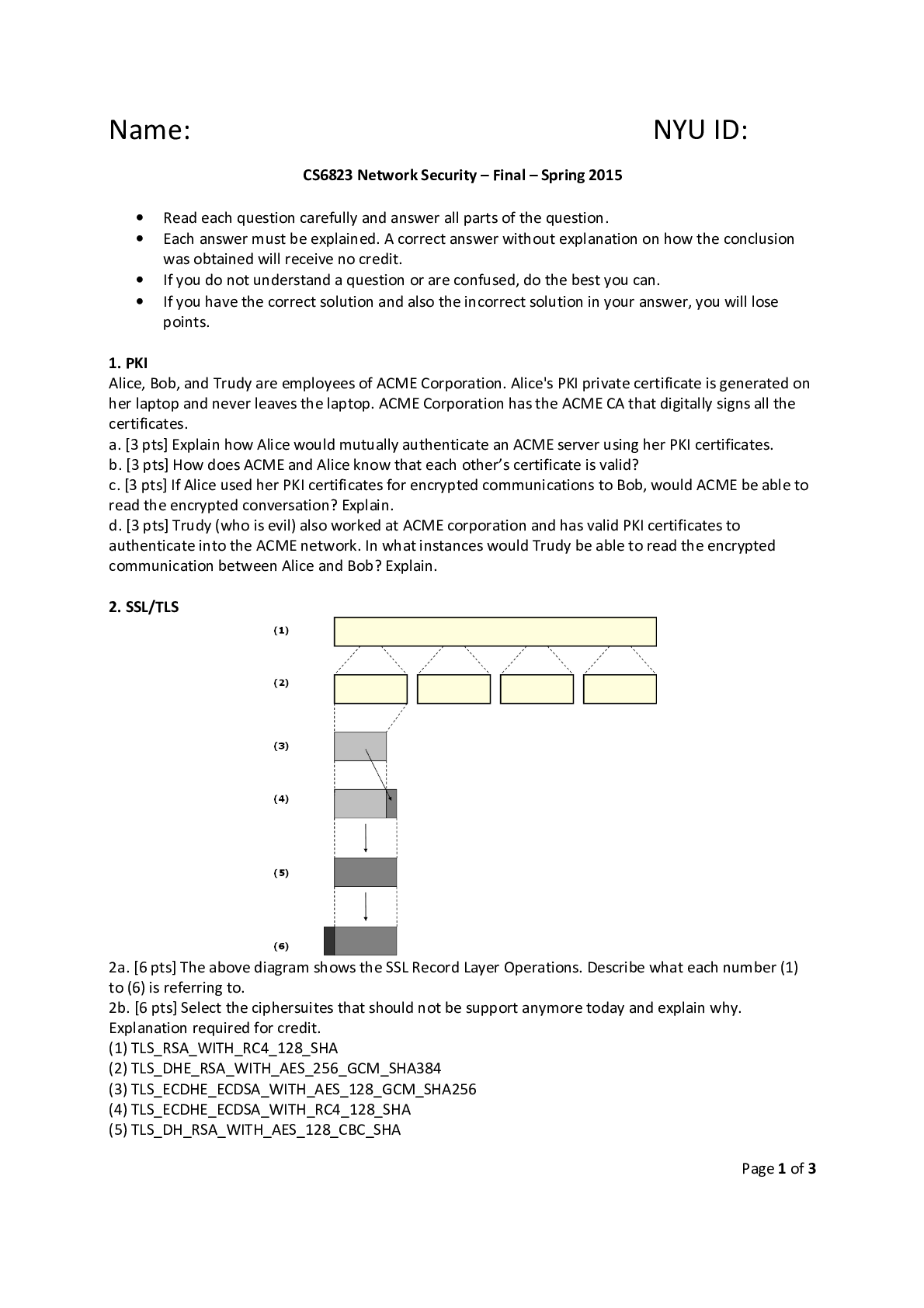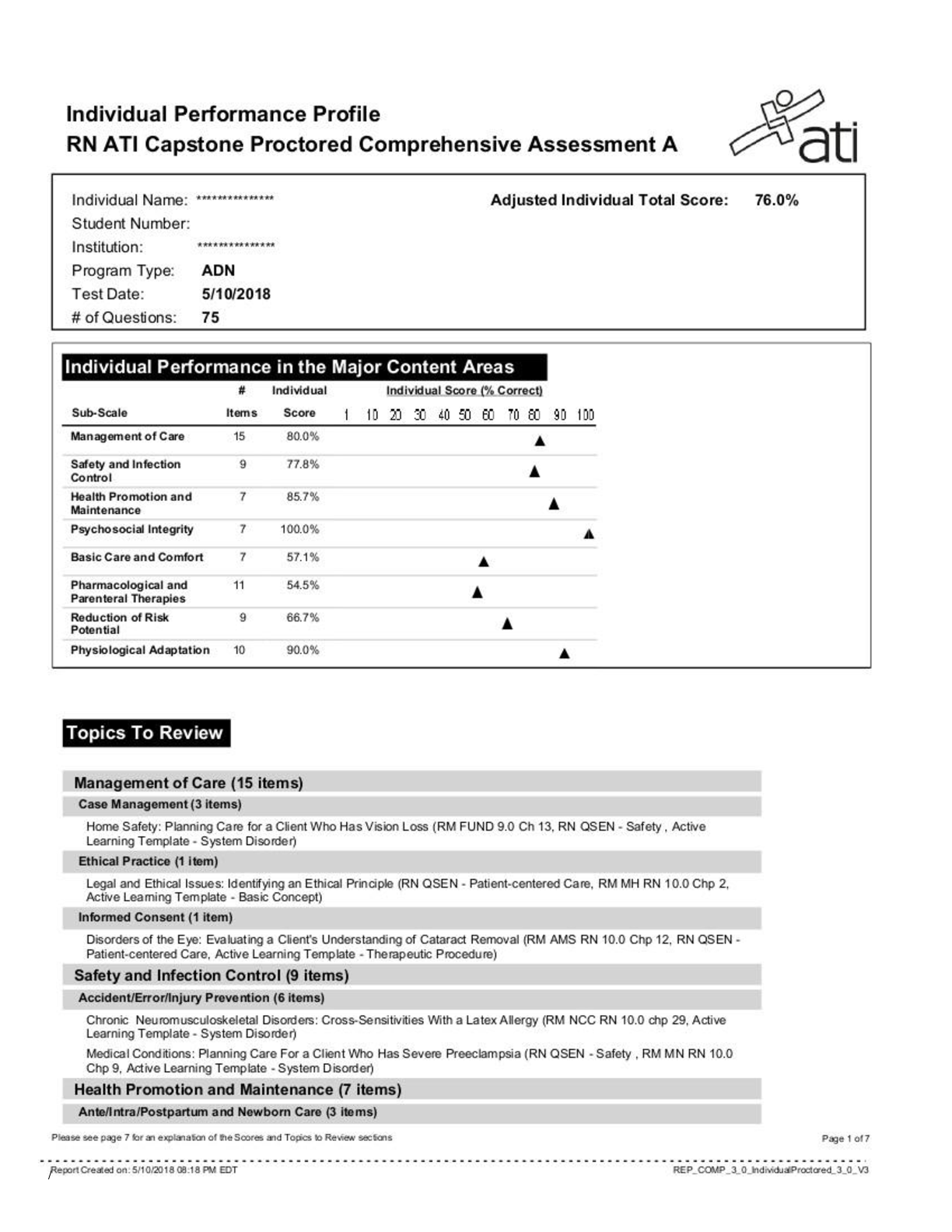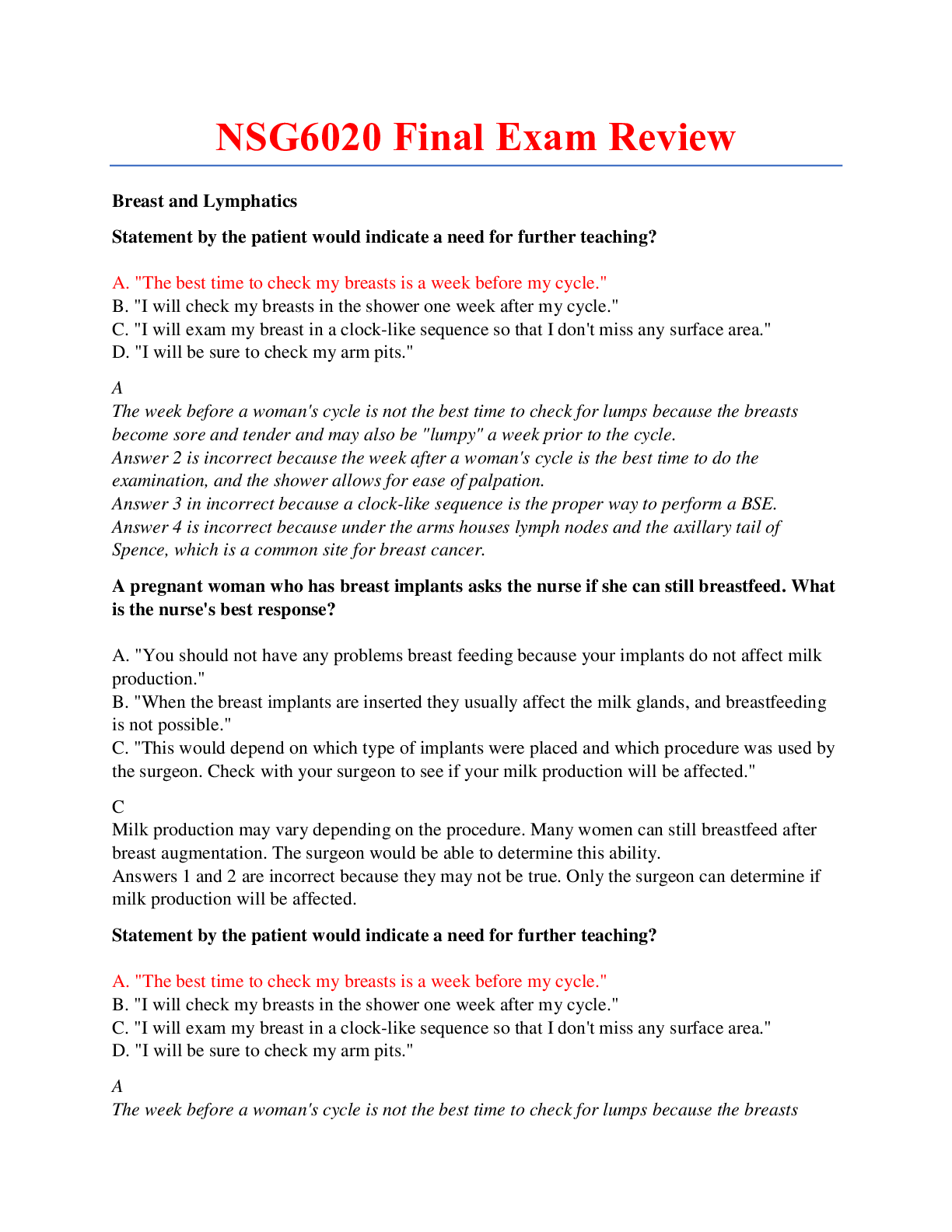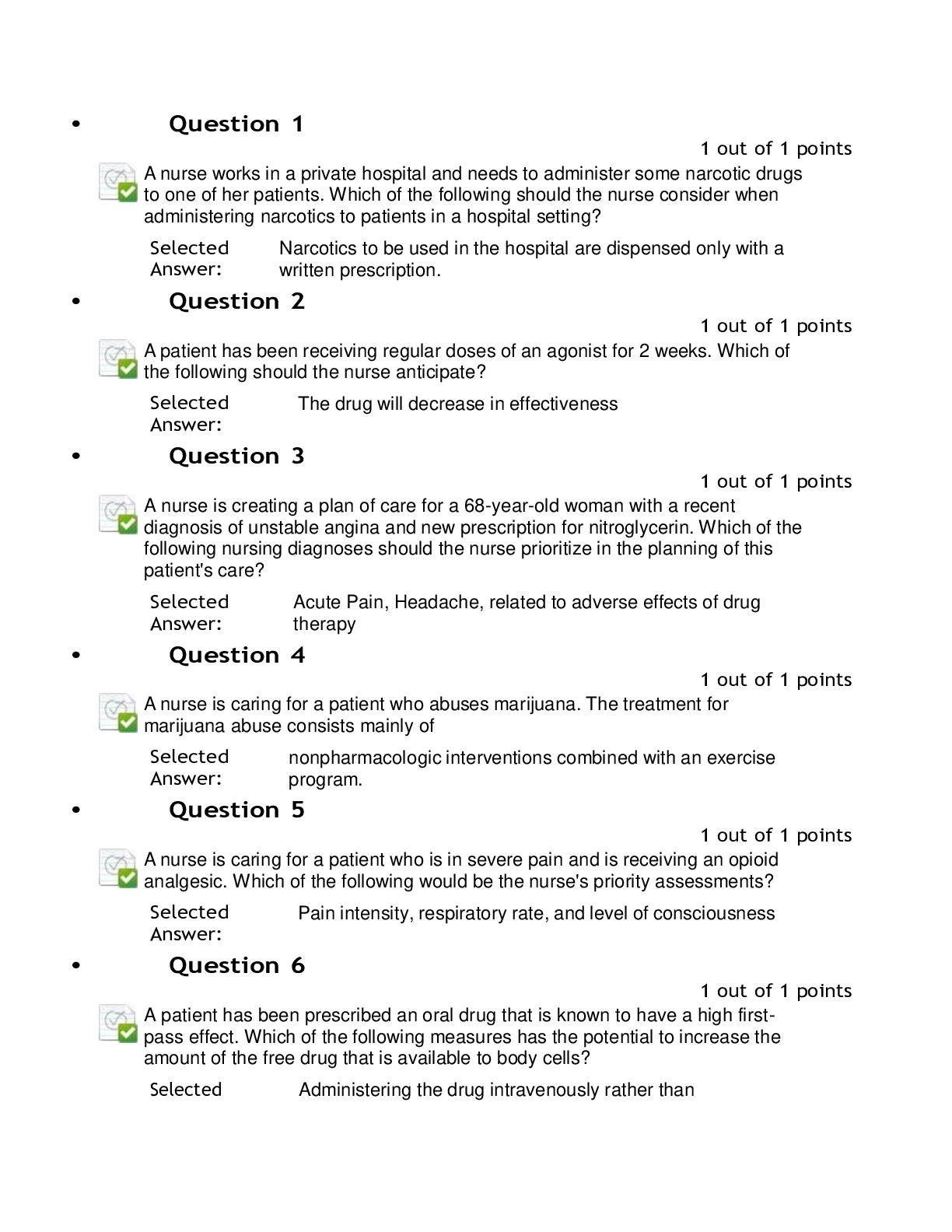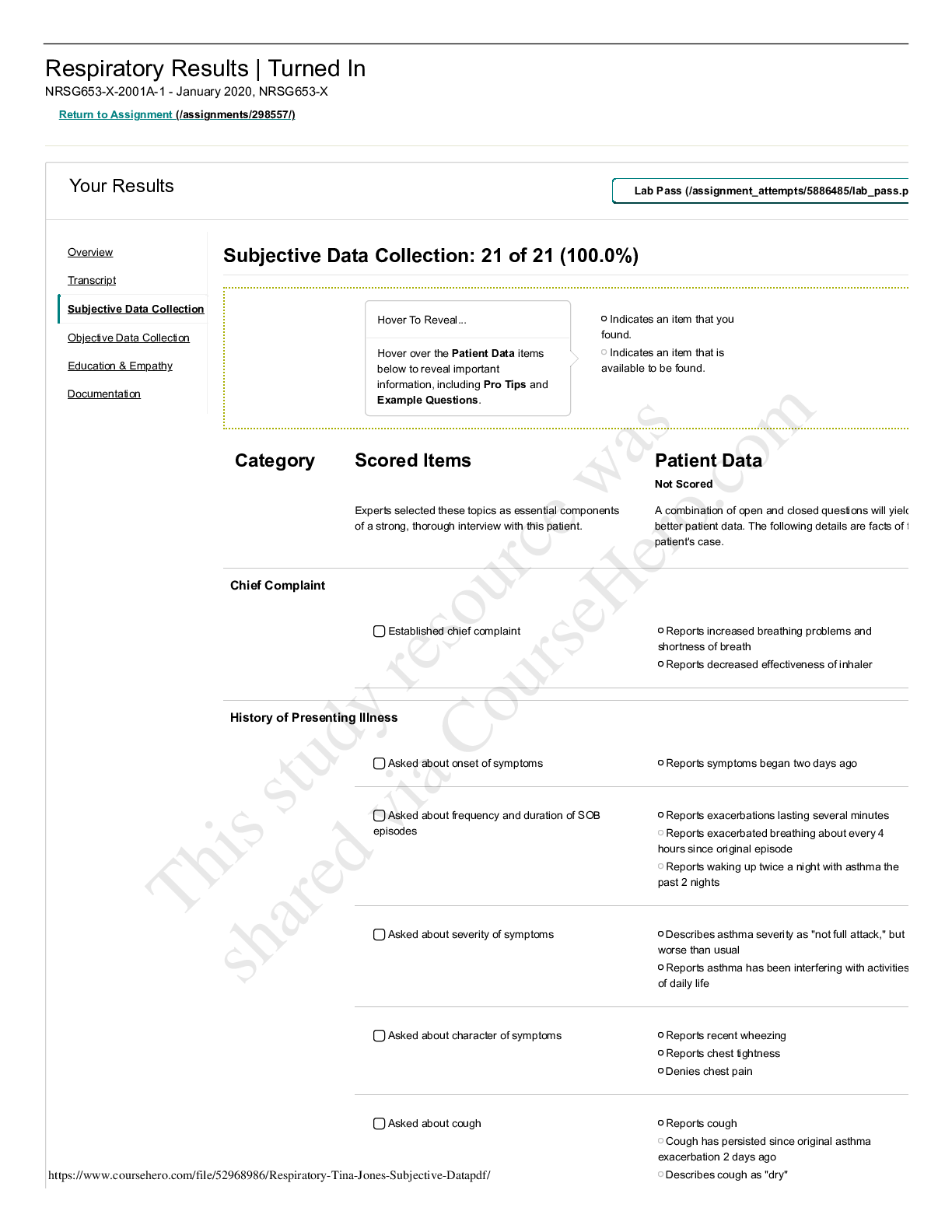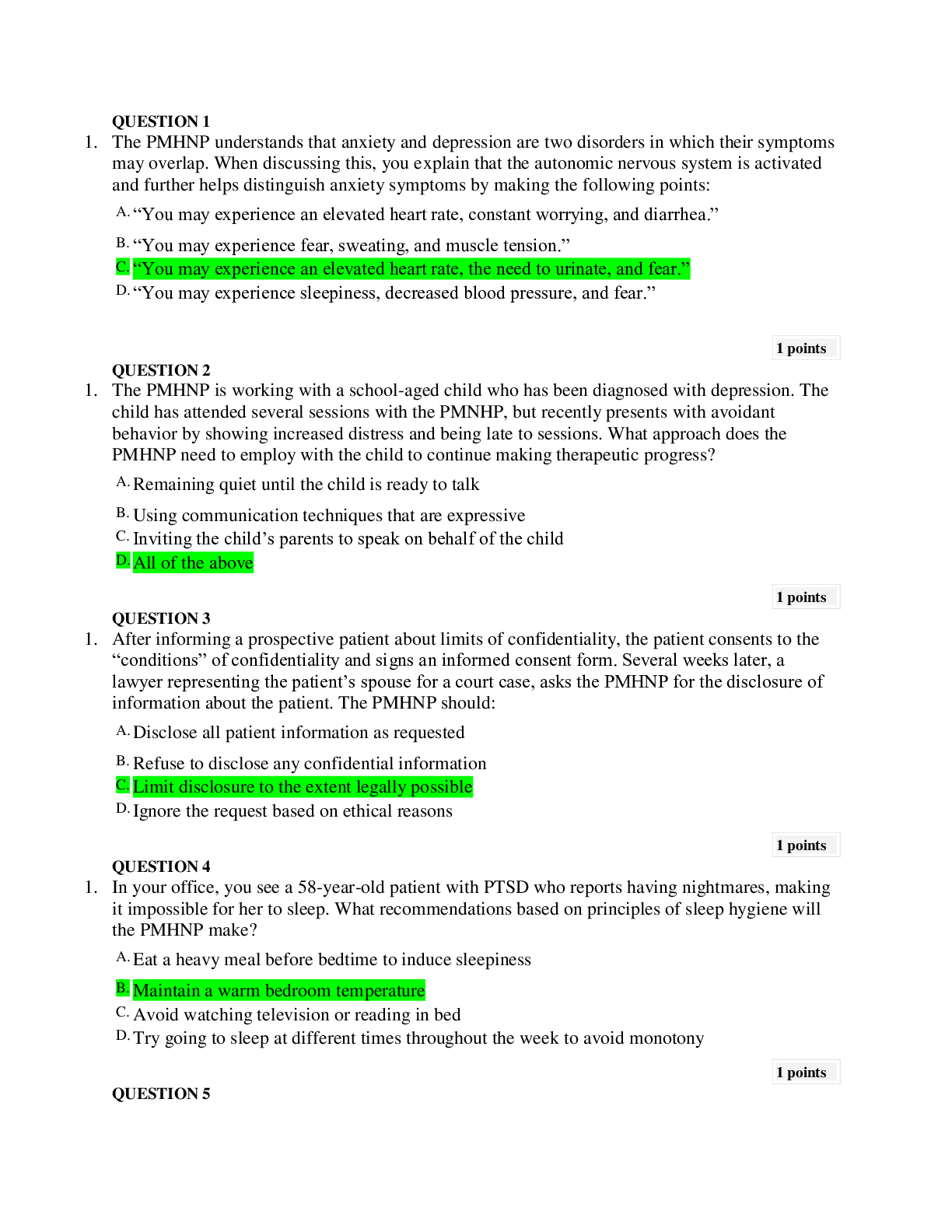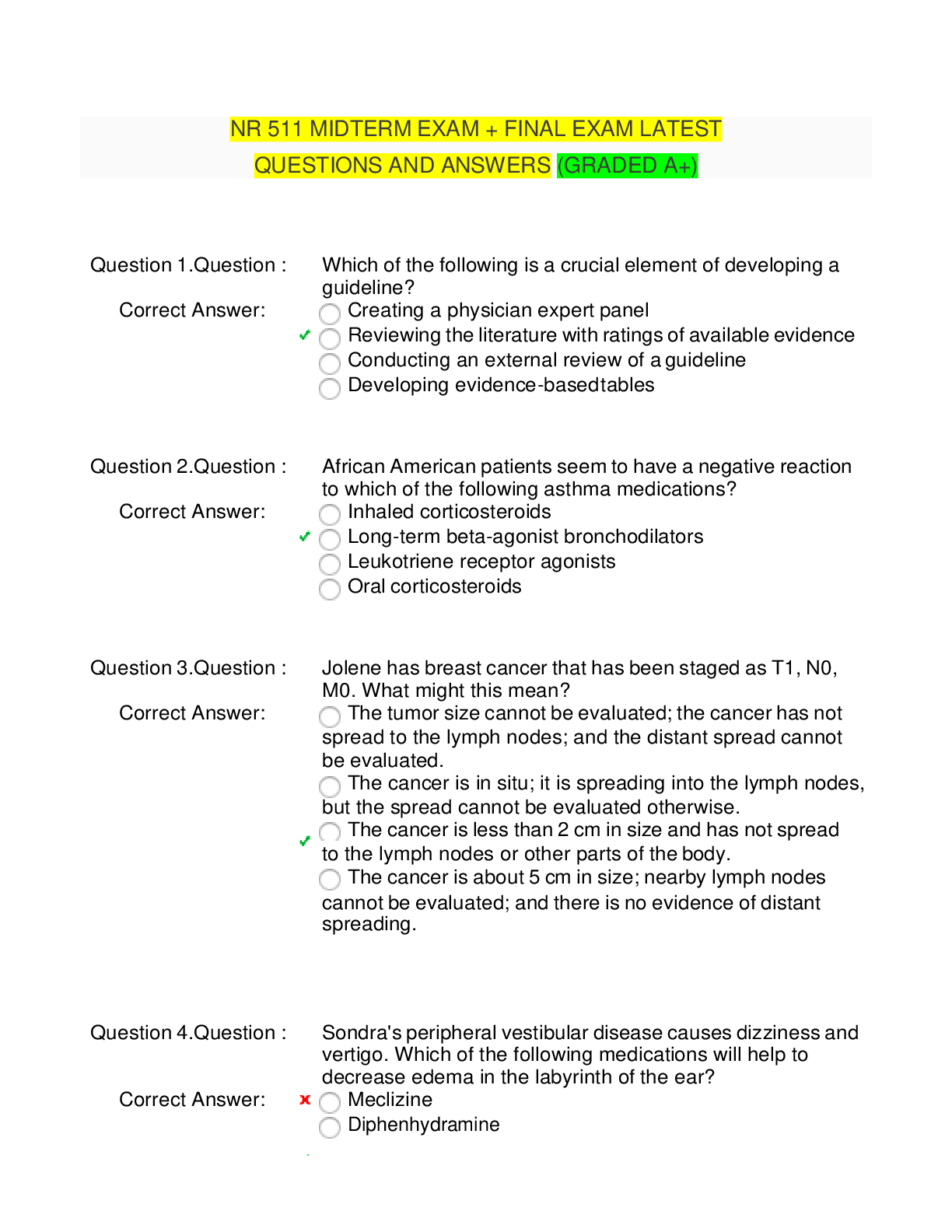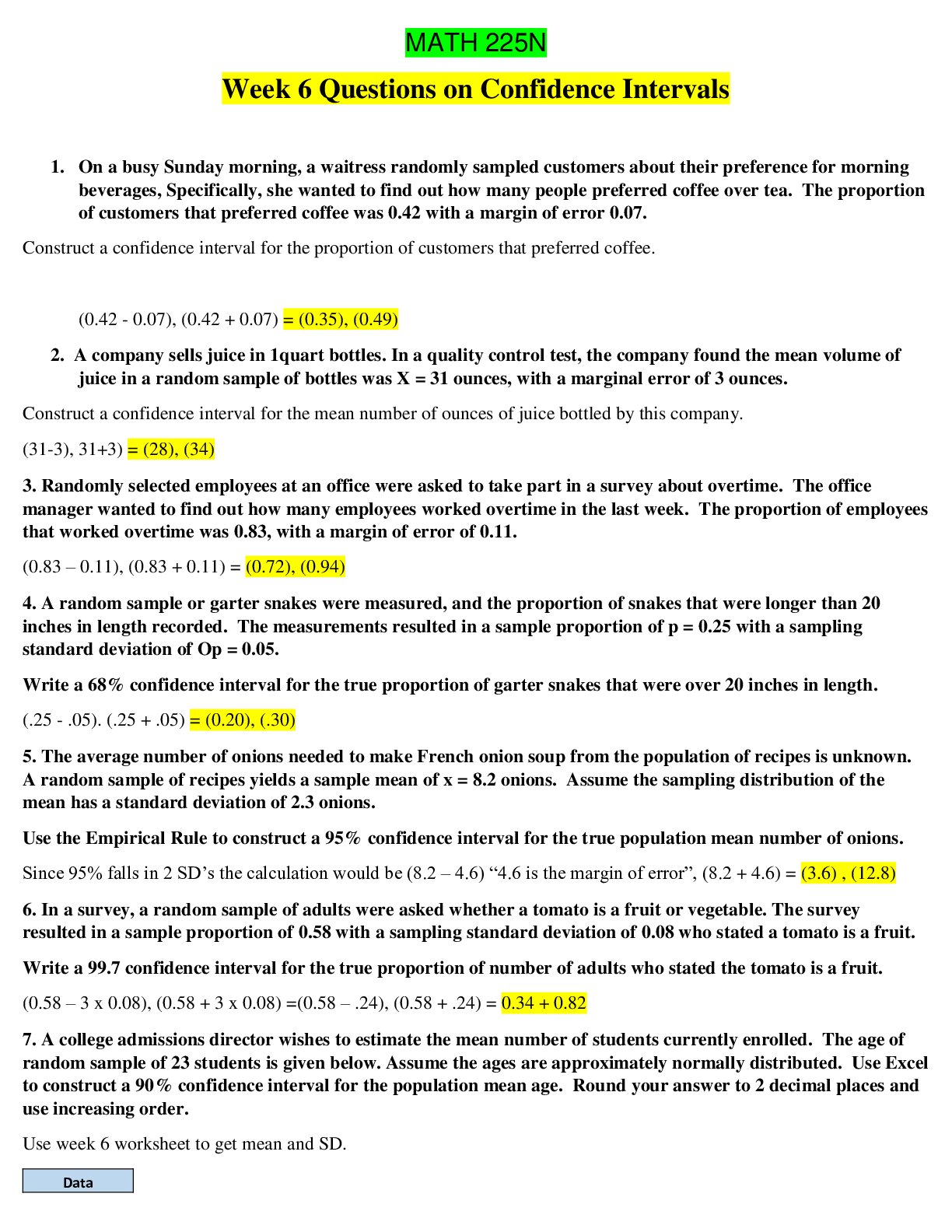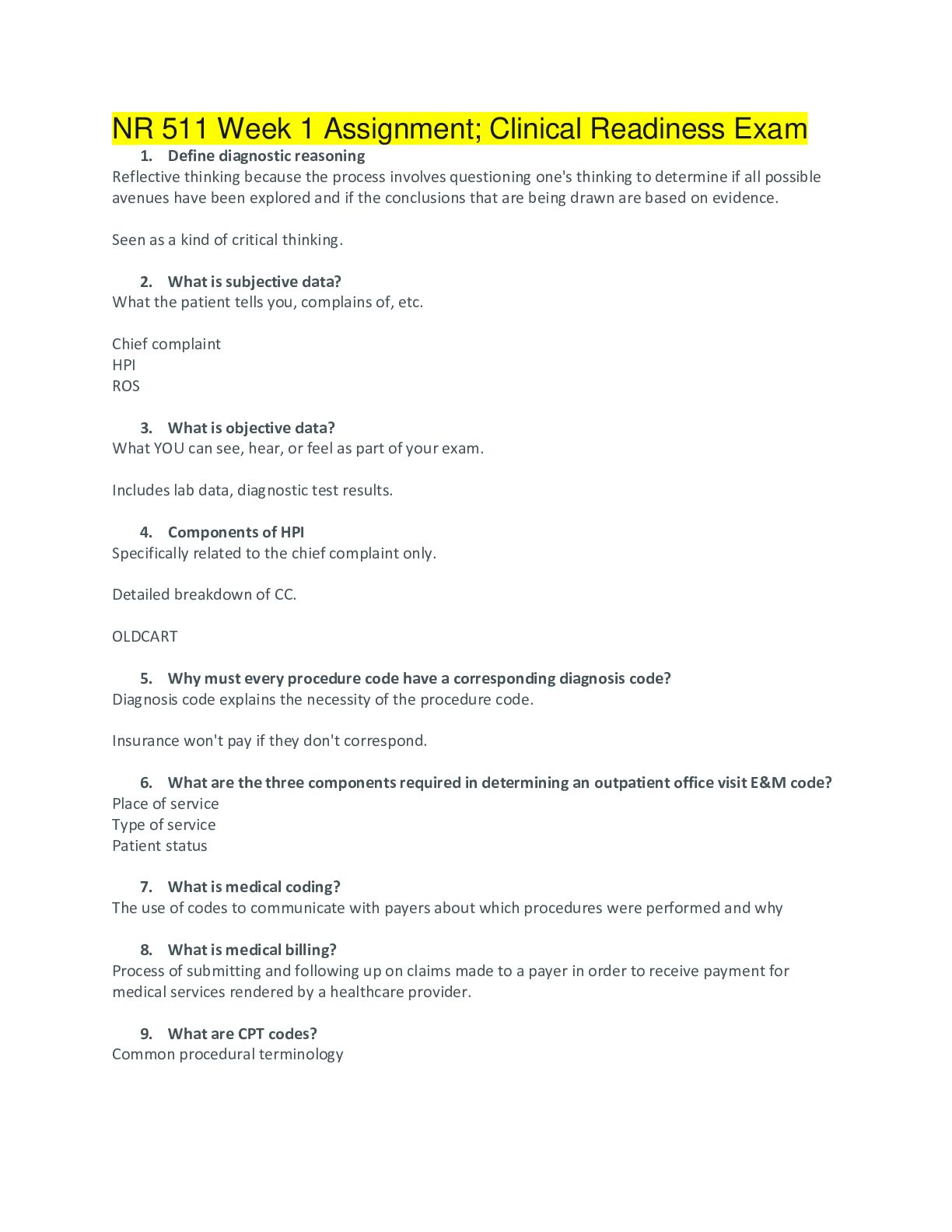Pharmacology > EXAM > Southern University and A&M College - PHARM 220: Pharmacology Ch 50-58 Questions and Answers (All)
Southern University and A&M College - PHARM 220: Pharmacology Ch 50-58 Questions and Answers
Document Content and Description Below
A patient is receiving an aluminum-containing antacid. The nurse will inform the patient to watch for which possible adverse effect? a. Diarrhea b. Constipation c. Nausea d. Abdominal cramping 2... . When reviewing the health history of a patient who will be receiving antacids, the nurse recalls that antacids containing magnesium need to be used cautiously in patients with which condition? a. Peptic ulcer disease b. Renal failure c. Hypertension d. Heart failure 3. The nurse is reviewing the medication orders for a patient who will be taking an H2 antagonist. Which drug may have an interaction if taken along with the H2 antagonist? a. Ibuprofen (Motrin) b. Ranitidine (Zantac) c. Tetracycline (Doryx) d. Ketoconazole (Nizoral) 4. A patient who has been taking cimetidine (Tagamet) for hyperacidity calls the clinic to say that the medication has not been effective. The nurse reviews his history and notes that which factor may be influencing the effectiveness of this drug? a. He takes the cimetidine with meals. b. He smokes two packs of cigarettes a day. c. He drinks a glass of water with each dose. d. He takes an antacid 3 hours after the cimetidine dose 5. A patient is taking omeprazole (Prilosec) for the treatment of gastroesophageal reflux disease (GERD). The nurse will include which statement in the teaching plan about this medication? a. “Take this medication once a day after breakfast.” b. “You will be on this medication for only 2 weeks for treatment of the reflux disease.” c. “The medication may be dissolved in a liquid for better absorption.” d. “The entire capsule must be taken whole, not crushed, chewed, or opened.” 6. A patient is complaining of excessive and painful gas. The nurse checks the patient’s medication orders and prepares to administer which drug for this problem? a. Famotidine (Pepcid) b. Aluminum hydroxide and magnesium hydroxide (Maalox or Mylanta) c. Calcium carbonate (Tums)d. Simethicone (Mylicon) 7. A 75-year-old woman comes into the clinic with complaints of muscle twitching, nausea, and headache. She tells the nurse that she has been taking sodium bicarbonate five or six times a day for the past 3 weeks. The nurse will assess for which potential problem that may occur with overuse of sodium bicarbonate? a. Constipation b. Metabolic acidosis c. Metabolic alkalosis d. Excessive gastric mucus 8. A patient will be taking a 2-week course of combination therapy with omeprazole (Prilosec) and another drug for a peptic ulcer caused by Helicobacter pylori. The nurse expects a drug from which class to be ordered with the omeprazole? a. Antibiotic b. Nonsteroidal anti-inflammatory drug c. Antacid d. Antiemetic 9. A patient is asking advice about which over-the-counter antacid is considered the most safe to use for heartburn. The nurse explains that the reason that calcium antacids are not used as frequently as other antacids is for which of these reasons? a. Their use may result in kidney stones. b. They cause decreased gastric acid production. c. They cause severe diarrhea. d. Their use may result in fluid retention and edema. 10. At 0900, the nurse is about to give morning medications, and the patient has asked for a dose of antacid for severe heartburn. Which schedule for the antacid and medications is correct? a. Give both the antacid and medications at 0900. b. Give the antacid at 0900, and then the medications at 0930. c. Give the medications at 0900, and then the antacid at 1000. d. Give the medications at 0900, and then the antacid at 0915. 11. During an admission assessment, the patient tells the nurse that he has been self-treating his heartburn for 1 year with over-the-counter Prilosec OTC (omeprazole, a proton pump inhibitor). The nurse is aware that this self-treatment may have which result? a. No serious consequences b. Prevention of more serious problems, such as an ulcer c. Chronic constipation d. Masked symptoms of serious underlying diseases12. An older adult patient had gastric surgery due to a gastrointestinal bleed 3 days ago, and he has been stable since the surgery. This evening, his daughter tells the nurse, “He seems to be more confused this afternoon. He’s never been like this. What could be the problem?” The nurse reviews the patient’s medication record and suspects that which drug could be the cause of the patient’s confusion? a. Cimetidine (Tagamet) b. Pantoprazole (Protonix) c. Clarithromycin (Biaxin) d. Sucralfate (Carafate) 13. The nurse is teaching a patient who will be taking a proton pump inhibitor as long-term therapy about potential adverse effects. Which statement is correct? a. Proton pump inhibitors can cause diarrhea. b. These drugs can cause nausea and anorexia. c. Proton pump inhibitors cause drowsiness. d. Long-term use of these drugs may contribute to osteoporosis. 14. A patient in the intensive care unit has a nasogastric tube and is also receiving a proton pump inhibitor (PPI). The nurse recognizes that the purpose of the PPI is which effect? a. Prevent stress ulcers b. Reduce bacteria levels in the stomach c. Reduce gastric gas formation (flatulence) d. Promote gastric motility 15. The nurse is providing patient teaching about antacids. Which statements about antacids are accurate? (Select all that apply.) a. Antacids reduce the production of acid in the stomach. b. Antacids neutralize acid in the stomach. c. Rebound hyperacidity may occur with calcium-based antacids. d. Aluminum-based antacids cause diarrhea. e. Magnesium-based antacids cause diarrhea. The nurse is giving oral mineral oil as an ordered laxative dose. The nurse will take measures to prevent which potential problem that may occur with mineral oil? a. Fecal impaction b. Electrolyte imbalances c. Lipid pneumonia d. Esophageal blockage 2. When administering a bulk-forming laxative, the nurse instructs the patient to drink the medication mixed in a full 8-ounce glass of water. Which statement best explains the rationale for this instruction? a. The water acts to stimulate bowel movements. b. The water will help to reduce the bulk of the intestinal contents. c. These laxatives may cause esophageal obstruction if taken with insufficient water. d. The water acts as a lubricant to produce bowel movements. 3. A patient will be taking bismuth subsalicylate (Pepto-Bismol) to control diarrhea. When reviewing the patient’s other ordered medications, the nurse recognizes that which medication or medication class will interact significantly with the Pepto-Bismol? a. Hypoglycemic drugs b. Antibiotics c. Acetaminophen (Tylenol) d. Antidepressants 4. A patient is about to undergo a diagnostic bowel procedure. The nurse expects which drug to be used to induce total cleansing of the bowel? a. Docusate sodium (Colace) b. Lactulose (Enulose) c. Mineral oil d. Polyethylene glycol 3350 (GoLYTELY) 5. While recovering from surgery, a 74-year-old woman started taking a stimulant laxative, senna (Senokot), to relieve constipation caused by the pain medications. Two weeks later, at her follow-up appointment, she tells the nurse that she likes how “regular” her bowel movements are now that she is taking the laxative. Which teaching principle is appropriate for this patient? a. She needs to be sure to take this medication with plenty of fluids. b. It is important to have a daily bowel movement to promote bowel health. c. Long-term use of laxatives often results in decreased bowel tone and may lead to dependency. d. She needs to switch to glycerin suppositories to continue having daily bowel movements.6. A patient asks the nurse about the difference between diphenoxylate with atropine (Lomotil) and the over-the-counter drug loperamide (Imodium). Which response by the nurse is correct? a. “Lomotil acts faster than Imodium.” b. “Imodium does not cause physical dependence.” c. “Lomotil is available in suppository form.” d. “Imodium is a natural antidiarrheal drug.” 7. A patient wants to prevent problems with constipation and asks the nurse for advice about which type of laxative is safe to use for this purpose. Which class of laxative is considered safe to use on a long-term basis? a. Emollient laxatives b. Bulk-forming laxatives c. Hyperosmotic laxatives d. Stimulant laxatives 8. When administering mineral oil, the nurse recognizes that it can interfere with the absorption of which substance? a. Fat-soluble vitamins b. Water-soluble vitamins c. Minerals d. Electrolytes 9. The nurse is reviewing the mechanism of action of antidiarrheal drugs. Which type of antidiarrheal medication works by decreasing the intestinal muscle tone and peristalsis of the intestines? a. Adsorbents such as Pepto-Bismol b. Anticholinergics such as belladonna alkaloids c. Probiotics such as Lactinex d. Lubricants such as mineral oil 10. The nurse is discussing the use of adsorbents such as bismuth subsalicylate (Pepto-Bismol) with a patient who has diarrhea. The nurse will warn the patient about which possible adverse effects? a. Dark stools and blue gums b. Urinary hesitancy c. Drowsiness and dizziness d. Blurred vision and headache 11. A patient who has been on antibiotic therapy for 2 weeks has developed persistent diarrhea. The nurse expects which medication class to be ordered to treat this diarrhea? a. Lubricants b. Adsorbents c. Anticholinergics d. Probiotics12. A patient will be taking bismuth subsalicylate (Pepto-Bismol) to control diarrhea. When reviewing the patient’s other ordered medications, the nurse recognizes that which medication will interact significantly with the Pepto-Bismol? a. Acetaminophen (Tylenol), an analgesic b. Levothyroxine (Synthroid), a thyroid replacement drug c. Warfarin (Coumadin), an anticoagulant d. Fluoxetine (Prozac), an antidepressant 13. A laxative has been ordered for a patient. The nurse checks the patient’s medical history and would be concerned if which condition is present? a. High ammonia levels due to liver failure b. Diverticulosis c. Abdominal pain of unknown origin d. Chronic constipation 14. A patient is severely constipated and needs immediate relief. The nurse knows that which class of laxative will provide the most rapid results? a. Bulk-forming laxative, such as psyllium (Metamucil) b. Stool softener, such as docusate salts (Colace) c. Magnesium hydroxide (MOM) d. Magnesium oxide tablets 15. A patient is receiving lactulose (Enulose) three times a day. The nurse knows that the patient is not constipated and is receiving this drug for which reason? a. High ammonia levels due to liver failure b. Prevention of constipation c. Chronic renal failure d. Chronic diarrhea 16. A patient is taking linaclotide (Linzess) to treat irritable bowel syndrome (IBS). The nurse will monitor this patient for which adverse effect? a. Chest pain b. Chronic constipation c. Abdominal pain d. Elevated blood glucose levels 17. The nurse is preparing to administer methylnaltrexone (Relistor), a peripherally acting opioid antagonist. This drug is appropriate for which patient? a. A patient with diarrhea b. A terminally ill patient who has opioid-induced constipation c. A patient who is scheduled for a colonoscopy d. A patient who will be having colon surgery in the morning18. A patient has been treated with alosetron (Lotronex) for severe irritable bowel syndrome (IBS) for 2 weeks. She calls the clinic and tells the nurse that she has been experiencing constipation for 3 days. The nurse will take which action? a. Advise the patient to increase intake of fluids and fiber. b. Advise the patient to hold the drug for 2 days. c. Instruct the patient to stop taking the drug and to come to the clinic right away to be evaluated. d. Instruct the patient to continue the alosetron and to take milk of magnesia for the constipation. 19. The nurse is reviewing the uses of oral laxatives. Which conditions are general contraindications to or cautions about the use of oral laxatives? (Select all that apply.) a. Irritable bowel syndrome b. Undiagnosed abdominal pain c. Nausea and vomiting d. Fecal impaction e. Ingestion of toxic substances f. Acute surgical abdomen Ch 52 Questions 1. A patient is receiving a tube feeding through a gastrostomy. The nurse expects that which type of drug will be used to promote gastric emptying for this patient? a. Prokinetic drugs, such as metoclopramide (Reglan) b. Serotonin blockers, such as ondansetron (Zofran) c. Anticholinergic drugs, such as scopolamine (Transderm-Scop) d. Neuroleptic drugs, such as chlorpromazine (Thorazine) 2. A patient who has AIDS has lost weight and is easily fatigued because of his malnourished state. The nurse anticipates an order for which antinausea drug to stimulate his appetite? a. Metoclopramide (Reglan), a prokinetic drug b. Dronabinol (Marinol), a tetrahydrocannabinoid c. Ondansetron (Zofran), a serotonin blocker d. Aprepitant (Emend), a substance P/NK1 receptor antagonist 3. A patient on chemotherapy is using ondansetron (Zofran) for treatment of nausea. The nurse will instruct the patient to watch for which adverse effect of this drug? a. Dizziness b. Diarrhea c. Dry mouth d. Blurred vision 4. A patient who has severe nausea and vomiting following a case of food poisoning comes to the urgent care center. When reviewing his medication history, the nurse notes that he has an allergy to procaine. The nurse would question an order for which antiemetic drug if ordered for this patient? a. Metoclopramide (Reglan) b. Promethazine (Phenergan) c. Phosphorated carbohydrate solution (Emetrol) d. Palonosetron (Aloxi) 5. A mother calls the pediatrician’s office to report that her 18-month-old child has eaten half of a bottle of baby aspirin. She says, “I have a bottle of syrup of ipecac. Should I give it to him? He seems fine right now. What do I do?” What is the nurse’s best response? a. “Go ahead and give him the ipecac, and then call 911.” b. “Don’t give him the ipecac. Call the Poison Control number immediately for instructions.” c. “Please come to the office right away so that we can check him.” d. “Go ahead and take him to the emergency room right now.”6. A patient is taking chemotherapy with a drug that has a high potential for causing nausea and vomiting. The nurse is preparing to administer an antiemetic drug. Which class of antiemetic drugs is most commonly used to prevent nausea and vomiting for patients receiving chemotherapy? a. Prokinetic drugs, such as metoclopramide (Reglan) b. Serotonin blockers, such as ondansetron (Zofran) c. Anticholinergic drugs, such as scopolamine d. Neuroleptic drugs, such as promethazine (Phenergan 7. A patient who has been newly diagnosed with vertigo will be taking an antihistamine antiemetic drug. The nurse will include which information when teaching the patient about this drug? a. The patient may skip doses if the patient is feeling well. b. The patient will need to avoid driving because of possible drowsiness. c. The patient may experience occasional problems with taste. d. It is safe to take the medication with a glass of wine in the evening to help settle the stomach. 8. A patient with motion sickness is planning a cross-country car trip and has a new prescription for a scopolamine transdermal patch (Transderm-Scop). The nurse provides teaching for the use of this patch medication. The patient shows a correct understanding of the teaching with which statement? a. “I will change the patch every day.” b. “I will change the patch every other day.” c. “I will change the patch every 3 days.” d. “I will remove the patch only if it stops working.” 9. A woman who is in the first trimester of pregnancy has been experiencing severe morning sickness. She asks, “I’ve heard that ginger tablets may be a natural way to ease the nausea and vomiting. Is it okay to try them?” What is the nurse’s best response? a. “They are a safe and natural remedy for nausea when you are pregnant.” b. “Go ahead and try them, but stop taking them once the nausea is relieved.” c. “Some health care providers do not recommend ginger during pregnancy. Let’s check with your provider.” d. “You will need to wait until after the first trimester to try them.” 10. The nurse is reviewing new postoperative orders and notes that the order reads, “Give hydroxyzine (Vistaril) 50 mg IV PRN nausea or vomiting.” The patient is complaining of slight nausea. Which action by the nurse is correct at this time? a. Hold the dose until the patient complains of severe nausea. b. Give the dose orally instead of intravenously. c. Give the patient the IV dose of hydroxyzine as ordered. d. Call the prescriber to question the route that is ordered.11. A patient is on a chemotherapy regimen in an outpatient clinic and is receiving a chemotherapy drug that is known to be highly emetogenic. The nurse will implement which interventions regarding the pharmacologic management of nausea and vomiting? (Select all that apply.) a. Giving antinausea drugs at the beginning of the chemotherapy infusion b. Administering antinausea drugs 30 to 60 minutes before chemotherapy is started c. For best therapeutic effects, medicating for nausea once the symptoms begin d. Observing carefully for the adverse effects of restlessness and anxiety e. Instructing the patient that the antinausea drugs may cause extreme drowsiness f. Instructing the patient to rise slowly from a sitting or lying position because of possible orthostatic hypotension Ch 53 Questions 1. The nurse is reviewing conditions caused by nutrient deficiencies. Conditions such as infantile rickets, tetany, and osteomalacia are caused by a deficiency in which vitamin or mineral? a. Vitamin D b. Vitamin C c. Zinc d. Cyanocobalamin (vitamin B12) 2. The nurse is preparing a plan of care for a patient undergoing therapy with vitamin A. Which nursing diagnosis is appropriate for this patient? a. Impaired tissue integrity related to vitamin deficiency b. Risk for injury related to night blindness caused by vitamin deficiency c. Impaired physical mobility (muscle weakness) related to vitamin deficiency d. Acute confusion related to vitamin deficiency 3. A patient is on vitamin D supplemental therapy. The nurse will monitor for which signs of toxicity during this therapy? a. Tinnitus b. Anorexia c. Diarrhea d. Hypotension 4. The nurse is counseling a patient about calcium supplements. Which dietary information is appropriate during this teaching session? a. “Take oral calcium supplements with meals.” b. “There are no drug interactions with calcium products.” c. “Avoid foods that are high in calcium, such as beef, egg yolks, and liver.” d. “Be sure to eat foods high in calcium, such as dairy products and salmon.” 5. The nurse will prepare to give which preparation to a newborn upon arrival in the nursery after delivery? a. Vitamin B1 (thiamine) b. Vitamin D (calciferol) c. Folic acid d. Vitamin K (AquaMEPHYTON) 6. A patient with a history of alcohol abuse has been admitted for severe weakness and malnutrition. The nurse will prepare to administer which vitamin preparation to prevent Wernicke’s encephalopathy? a. Vitamin B3 (niacin) b. Vitamin B1 (thiamine) c. Vitamin B6 (pyridoxine)d. Folic acid 7. Niacin is prescribed for a patient who has hyperlipidemia. The nurse checks the patient’s medical history, knowing that this medication is contraindicated in which disorder? a. Renal disease b. Cardiac disease c. Liver disease d. Diabetes mellitus 8. A patient will be starting vitamin D supplements. The nurse reviews his medical record for contraindications, including which condition? a. Renal disease b. Cardiac disease c. Hypophosphatemia d. There are no contraindications to vitamin D supplements. 9. A patient accidentally took an overdose of the anticoagulant warfarin (Coumadin), and the nurse is preparing to administer vitamin K as an antidote. Which statement about vitamin K is accurate? a. The vitamin K dose will be given intramuscularly. b. The patient will take oral doses of vitamin K after the initial injection. c. The vitamin K cannot be given if the patient has renal disease. d. The patient will be unresponsive to warfarin therapy for 1 week after the vitamin K is given. 10. A newly admitted patient has orders for a zinc supplement. The nurse reviews the patient’s medical history and concludes that the zinc is ordered for which reason? a. To treat pellagra b. To aid in wound healing c. To treat osteomalacia d. As an antidote for anticoagulant overdose 11. The nurse is reviewing vitamin therapy in preparation for a nutrition class. Which statements are accurate regarding vitamin C (ascorbic acid)? (Select all that apply.) a. Vitamin C is important in the maintenance of bone, teeth, and capillaries. b. Vitamin C is essential for night vision. c. Vitamin C is important for tissue repair. d. Vitamin C is found in animal sources such as dairy products and meat. e. Vitamin C is found in tomatoes, strawberries, and broccoli. f. Vitamin C is also known as the “sunshine vitamin.” g. Vitamin C deficiency is known as scurvy.12. The patient asks the nurse about taking large doses of vitamin C to improve her immunity to colds. “It’s just a vitamin, right? What can happen?” Which responses by the nurse are correct? (Select all that apply.) a. “Vitamin C is harmless because it is a water-soluble vitamin.” b. “Large doses of vitamin C can cause nausea, vomiting, headache, and abdominal cramps.” c. “Keep in mind that if you suddenly stop taking these large doses, you might experience symptoms similar to scurvy.” d. “Studies have shown that vitamin C has little value in preventing the common cold.” e. “Vitamin C acidifies the urine, which can lead to the formation of kidney stones.” f. “Large doses of vitamin C may delay wound healing.” 13. During an intravenous infusion of calcium, the nurse carefully monitors the patient for symptoms of hypercalcemia. Which are symptoms of hypercalcemia? (Select all that apply.) a. Anorexia b. Nausea and vomiting c. Diarrhea d. Constipation e. Cardiac irregularities f. Drowsiness Ch 54 Questions 1. A patient is to receive iron dextran injections. Which technique is appropriate when the nurse is administering this medication? a. Intravenous administration mixed with 5% dextrose b. Intramuscular injection in the upper arm c. Intramuscular injection using the Z-track method d. Subcutaneous injection into the abdomen 2. A nurse is giving instructions to a patient who will be receiving oral iron supplements. Which instructions will be included in the teaching plan? a. Take the iron tablets with milk or antacids. b. Crush the pills as needed to help with swallowing. c. Take the iron tablets with meals if gastrointestinal distress occurs. d. If black tarry stools occur, report it to the doctor immediately. 3. The nurse will teach a patient who is receiving oral iron supplements to watch for which expected adverse effects? a. Palpitations b. Drowsiness and dizziness c. Black, tarry stools d. Orange-red discoloration of the urine 4. A patient has been taking iron supplements for anemia for 2 months. During a follow-up assessment, the nurse will observe for which therapeutic response? a. Decreased weight b. Increased activity tolerance c. Decreased palpitations d. Increased appetite 5. An oral iron supplement is prescribed for a patient. The nurse would question this order if the patient’s medical history includes which condition? a. Decreased hemoglobin b. Hemolytic anemia c. Weakness d. Concurrent therapy with erythropoietics 6. The nurse is reviewing the medical record of a patient before giving a new order for iron sucrose (Venofer). Which statement regarding the administration of iron sucrose is correct? a. The medication is given with food to reduce gastric distress. b. Iron sucrose is contraindicated if the patient has renal disease. c. A test dose will be administered before the full dose is given. d. The nurse will monitor the patient for hypotension during the infusion.7. The nurse is teaching a patient with iron-deficiency anemia about foods to increase iron intake. Which food may enhance the absorption of oral iron forms? a. Milk b. Yogurt c. Antacids d. Orange juice 8. The nurse is administering liquid oral iron supplements. Which intervention is appropriate when administering this medication? a. Have the patient take the liquid iron with milk. b. Instruct the patient to take the medication through a plastic straw. c. Have the patient sip the medication slowly. d. Have the patient drink the medication, undiluted, from the unit-dose cup. 9. A woman who is planning to become pregnant should ensure that she receives adequate levels of which supplement to reduce the risk for fetal neural tube defects? a. Vitamin B12 b. Vitamin D c. Iron d. Folic acid 10. The nurse is administering folic acid to a patient with a new diagnosis of anemia. Which statement about treatment with folic acid is true? a. Folic acid is used to treat any type of anemia. b. Folic acid is used to treat iron-deficiency anemia. c. Folic acid is used to treat pernicious anemia. d. The specific cause of the anemia needs to be determined before treatment. 11. During therapy with the hematopoietic drug epoetin alfa (Epogen), the nurse instructs the patient about adverse effects that may occur, such as: a. Anxiety. b. Drowsiness. c. Hypertension. d. constipation. 12. The nurse is administering intravenous iron dextran for the first time to a patient with anemia. After giving a test dose, how long will the nurse wait before administering the remaining portion of the dose? a. 30 minutes b. 1 hour c. 6 hours d. 24 hours13. A patient with end-stage renal failure has been admitted to the hospital for severe anemia. She is refusing blood transfusions. The nurse anticipates drug therapy with which drug to stimulate the production of red blood cells? a. Folic acid b. Cyanocobalamin (vitamin B12) c. Epoetin alfa (Epogen) d. Filgrastim (Neupogen) 14. A cancer patient is receiving drug therapy with epoetin alfa (Epogen). The nurse knows that the medication must be stopped if which laboratory result is noted? a. White blood cell count of 550 cells/mm3 b. Hemoglobin level of 12 g/dL c. Potassium level of 4.2 mEq/L d. Glucose level of 78 mg/dL 15. A patient has been receiving epoetin alfa (Epogen) for severe iron-deficiency anemia. Today, the provider changed the order to darbepoetin (Aranesp). The patient questions the nurse, “What is the difference in these drugs?” Which response by the nurse is correct? a. “There is no difference in these two drugs.” b. “Aranesp works faster than Epogen to raise your red blood cell count.” c. “Aranesp is given by mouth, so you will not need to have injections.” d. “Aranesp is a longer-acting form, so you will receive fewer injections.” 16. A patient will be taking oral iron supplements at home. The nurse will include which statements in the teaching plan for this patient? (Select all that apply.) a. Take the iron tablets with meals. b. Take the iron tablets on an empty stomach 1 hour before meals. c. Take the iron tablets with an antacid to prevent heartburn. d. Drink 8 ounces of milk with each iron dose. e. Taking iron supplements with orange juice enhances iron absorption. f. Stools may become loose and light in color. g. Stools may become black and tarry. h. Tablets may be crushed to enhance iron absorp Ch 55 Questions 1. A patient is receiving a nutritional supplement via an enteral feeding tube. The nurse will monitor for which common adverse effect? a. Diarrhea b. Constipation c. Fluid overload d. Heartburn 2. An older adult patient needs to receive an enteral supplement to improve her overall nutritional status. When considering enteral supplements, the nurse notes that which formulation provides complex nutrients? a. Ensure Plus b. Moducal c. Propac d. Microlipid 3. A woman has been receiving both radiation and chemotherapy for her cancer. Lately, she has developed anorexia caused by the treatments, so she needs short-term nutrition supplementation. The nurse anticipates that the physician will initiate which therapy? a. Central total parenteral nutrition b. Peripheral parenteral nutrition c. Oral nutritional supplements with meals d. Nasogastric enteral supplementation 4. During the night shift, a patient’s total parenteral nutrition (TPN) infusion ran out, and the nurse discovered that there was no TPN solution on hand to continue the infusion. The pharmacy is closed and will not reopen for 5 hours. The nurse will have to implement measures to prevent which consequence of abruptly discontinuing TPN infusions? a. Dehydration b. Hyperglycemia c. Dumping syndrome d. Rebound hypoglycemia 5. When monitoring a patient who has been receiving peripheral parenteral nutrition for more than 3 weeks, the nurse will watch for which potential complication? a. Diarrhea b. Phlebitis c. Hypernatremia d. Hypoglycemia6. A patient has been receiving total parenteral nutrition. Upon assessment, the nurse notes these assessment findings: blood pressure 150/92 mm Hg (elevated from previous readings); pulse rate 110 beats/min and weak; pitting edema on both ankles; and new-onset confusion. The nurse suspects that the patient is experiencing which condition? a. Infection b. Hypoglycemia c. Hyperglycemia d. Fluid overload 7. The peripheral parenteral nutrition bag that has been infusing into the patient is empty, and the nurse realizes that the next bag is not ready. The nurse should immediately hang which of these intravenous solutions until the new bag arrives? a. 10% dextrose in water b. 20% dextrose in water c. 0.9% sodium chloride d. Lactated Ringer’s solution 8. The nurse is preparing to administer medications to a patient who is receiving a feeding via a gastric tube. When reviewing the patient’s medication list, the nurse notes a potential concern about a food-drug interaction if which medication is listed? a. Multivitamin solution b. Phenytoin (Dilantin) c. Metoclopramide (Reglan) d. Warfarin (Coumadin) 9. A patient with type 2 diabetes will be receiving a nasogastric tube feeding for a few days. The nurse expects which type of formula to be used? a. Jevity b. Ensure Plus c. Glucerna d. Polycose 10. A patient with a partial bowel obstruction will be given a 1-week course of enteral tube feeding via a nasogastric tube. Which formulation is appropriate for this patient? a. Vivonex Plus, an elemental formulation b. Osmolite, a polymeric formulation c. Glucerna, a formulation for impaired glucose tolerance d. Polycose, a modular formulation that contains carbohydrates 11. The nurse is administering a parenteral nutrition infusion to a patient. The nurse will implement which measures to prevent infection? (Select all that apply.) a. Change the intravenous tubing set every 72 hours. b. Change the intravenous tubing set every time a new bag is added to the infusion.c. Use a 1.2-micron filter with each tubing set. d. Monitor the patient’s temperature every shift during the infusion. e. Report any increase in the patient’s temperature over 100° F (37.8° C). Ch 56 Questions 1. A father calls because his son has head lice. He reports that he used Kwell shampoo three times, but nothing happened.” He wants to know what to do now. What will the nurse advise first? a. “It sounds like you need a prescription for a second product, malathion.” b. “Try one of the lotion products instead.” c. “Be sure to use a nit comb to remove nits from the hair shafts.” d. “Try combing through the hair with mineral oil to loosen the lice from the hair shafts.” 2. A teenage boy is taking tretinoin (Retin-A) for acne. Which statement will the nurse include in the teaching plan? a. “Avoid foods that are heavy in salt and oils.” b. “This drug may cause increased redness of your skin.” c. “Try using an abrasive cleanser to remove old skin layers.” d. “Being out in the sunlight will help your skin heal.” 3. The preoperative nurse is ready to perform a skin prep with povidone-iodine (Betadine) on a patient who is about to have abdominal surgery. Which allergies, if present, would be a contraindication to the Betadine prep? a. Peanuts b. Shellfish c. Adhesives d. Latex 4. A woman suffered a second-degree burn of the skin on her arm and hand while cooking breakfast. After examination in the urgent care center, silver sulfadiazine cream (Silvadene) is ordered for the burned area. The nurse will apply the medication using which procedure? a. Gently patting a moderate amount over the burned area b. Massaging the cream completely into the wound c. Applying a thick layer over the burned area, and then leaving the area open d. Applying a thin layer with a sterile, gloved hand to clean and débrided areas 5. A patient asks about using minoxidil (Rogaine) for hair thinning. Which statement about minoxidil is accurate? a. The product is applied once daily in the morning. b. Systemic absorption of topically applied minoxidil is rare. c. Results may be seen as soon as 2 weeks after beginning therapy. d. Systemic absorption may cause tachycardia, fluid retention, and weight gain. 6. A child has been diagnosed with impetigo, a skin infection. The nurse anticipates that which drug will be used to treat this condition? a. Spinosad (Natroba) b. Nystatin (Mycostatin)c. Acyclovir (Zovirax) d. Bacitracin 7. A 55-year-old obese patient was diagnosed with candidiasis in the skin folds under her breasts. When the nurse sees her at a follow-up visit 2 months later, she complains that it has returned. She said she applied the medicine for 1 week and stopped because the itching stopped and the cream was messy. Which statement is true regarding fungal infections of the skin? a. Fungal infections often require prolonged therapy. b. The patient has a new infection now. c. The patient needs to apply a dressing if the cream is too messy. d. This infection will probably never be cured. 8. A female patient will be starting therapy with oral isotretinoin (Amnesteem) as part of treatment for severe acne, and the nurse is providing teaching. Which teaching point will the nurse include in her teaching plan about isotretinoin? a. “You will have to use two contraceptive methods while on this drug.” b. “You must avoid sexual activity while on this drug.” c. “You will have to avoid pregnancy for 2 weeks after taking this drug.” d. “If you are taking an oral contraceptive, you may take this drug.” 9. A patient is admitted to the hospital for possible septicemia. He has a large pressure ulcer on his heel that is open and includes necrotic tissue. However, his prothrombin time/international normalized ratio (PT/INR) values are too high to permit surgical débridement at this time. The nurse expects that which wound-care product will be used to treat the wound? a. Cadexomer iodine (Iodosorb) b. Biafine topical emulsion c. Povidone-iodine (Betadine) d. Collagenase (Santyl) 10. The nurse is reviewing laboratory results for a patient and notes that the patient has positive results for nasal colonization by methicillin-resistant Staphylococcus aureus (MRSA). The nurse anticipates an order for which medication? a. Acyclovir (Zovirax) b. Mupirocin (Bactroban) c. Clindamycin (Cleocin T) d. Clotrimazole (Lotrimin) 11. The nurse is reviewing the medical record of a patient who is to receive wound care with topical silver sulfadiazine (Silvadene). Which finding, if noted, would be a potential contraindication? a. The patient has an open wound from a burn on her arm. b. The patient is allergic to sulfonamide drugs. c. The patient is allergic to shellfish. d. The patient’s burn wound has been débrided.12. A patient is considering taking oral aloe supplements and asks the nurse about potential problems with this therapy. Which statement by the nurse is correct? a. “Aloe is not taken orally; it is only used topically to aid in wound healing.” b. “Aloe is used by some to treat constipation; it may cause diarrhea.” c. “This is a safe herbal supplement, with no known drug interactions.” d. “This is a safe herbal supplement, with no known adverse effects.” 13. A female patient has been taking isotretinoin (Amnesteem) for 3 months. During a follow-up appointment, which statement by the patient would be of highest concern to the nurse? a. “I am using two forms of contraception while on this drug.” b. “I have been feeling rather down and lonely lately.” c. “I wish I didn’t have to be on this medication.” d. “It’s scary to know that this drug can cause birth defects.” 14. Which adverse effects will the nurse expect in a teenage patient who is using topical tretinoin (Retin-A)? (Select all that apply.) a. Crusted skin b. Itching c. Altered skin pigmentation d. Rosacea e. Red and edematous blisters 15. A patient has a prescription for topically applied 5% fluorouracil (Efudex) cream as part of treatment for basal cell carcinoma on her cheek. Which instructions will the nurse provide to the patient? (Select all that apply.) a. “You must use gloves to apply this medication.” b. “You can use clean fingertips to apply the cream, but be sure to wash your hands afterward.” c. “You will need to stay out of the sun during therapy with this medication.” d. “Apply this medication to the affected site once a day in the evening.” e. “Apply this medication to the affected site twice daily.” f. “You may have swelling, scaling, burning, Ch 57 Questions 1. The nurse will be giving ophthalmic drugs to a patient with glaucoma. Which drug is given intravenously to reduce intraocular pressure when other medications are not successful? a. Tobramycin (Tobrex) b. Bacitracin (AK-Tracin) c. Mannitol (Osmitrol) d. Ketorolac (Acular) 2. The nurse is reviewing the use of ophthalmic preparations. Indications for the direct- and indirect-acting miotics include which condition? a. Cataracts b. Removal of foreign bodies c. Open-angle glaucoma d. Ocular infections 3. A patient has a new prescription for an antiglaucoma eyedrop. The next day, she calls the clinic and states, “The package insert says this medication might make my blue eyes turn brown! Is this true?” The nurse realizes that the patient has a prescription for which eye medication? a. Latanoprost (Xalatan), a prostaglandin agonist b. Dorzolamide (Trusopt), an ocular carbonic anhydrase inhibitor c. Betaxolol (Betoptic), a direct-acting beta blocker d. Pilocarpine (Pilocar), a direct-acting cholinergic 4. A patient has been taking the corticosteroid dexamethasone (Decadron) but has developed bacterial conjunctivitis and has a prescription for gentamicin (Garamycin) ointment. The nurse notes that which interaction is possible if the two drugs are used together? a. The infection may become systemic. b. The gentamicin effects may become more potent. c. The corticosteroid may cause overgrowth of nonsusceptible organisms. d. Immunosuppression may make it more difficult to eliminate the eye infection. 5. When teaching a patient about the proper application of timolol (Timoptic) eyedrops, the nurse will include which instruction? a. “Apply the drops into the conjunctival sac instead of directly onto the eye.” b. “Apply the drops directly to the eyeball (cornea) for the best effect.” c. “Blot your eye with a tissue immediately after applying the drops.” d. “Tilt your head forward before applying the eyedrops.” 6. A patient is about to undergo ocular surgery. The preoperative nurse anticipates that which drug will be used for local anesthesia? a. Oral glycerin b. Proparacaine (Alcaine)c. Timolol (Timoptic) d. Dipivefrin (Propine) 7. A patient with an eye injury requires an ocular examination to detect the presence of a foreign body. The nurse anticipates that which drug will be used for this examination? a. Phenylephrine (Neo-Synephrine) b. Fluorescein sodium (AK-Fluor) c. Atropine sulfate (Isopto Atropine) d. Olopatadine (Patanol) 8. The nurse is administering antibiotic eyedrops to a patient for the first time. After the first drop is given, the patient states, “That eyedrop is making my eye sting! Is that normal?” Which is the best response by the nurse? a. “That’s unusual. Let me rinse the medication from your eye.” b. “Sometimes these eyedrops may cause burning and stinging, but it should go away soon.” c. “These may be serious side effects, so I will notify your doctor before the next dose is due.” d. “Let’s wait and see if these effects happen the next time you receive these drops.” 9. A patient is receiving ocular cyclosporine (Restasis) and also has an order for an artificial tears product. The nurse includes which instructions in the teaching plan for these medications? a. “These two eye drugs cannot be given together. Let’s check with your prescriber.” b. “You may take these two drugs together at the same time.” c. “First take the artificial tears, and then take the Restasis after 5 minutes.” d. “Take the Restasis first, and then wait 15 minutes before taking the artificial tears.” 10. The nurse is reviewing the medical record of a patient and notes an order for ophthalmic dexamethasone (Decadron) solution. The nurse knows that indications for ophthalmic dexamethasone include which conditions? (Select all that apply.) a. Uveitis b. Allergic conditions c. Removal of foreign bodies d. Ocular infections e. Glaucoma f. Conjunctival inflammation 11. The nurse is administering ophthalmic drops. Place the following administration steps in the correct order. (Select all that apply.) a. Close the eye gently. b. Apply gentle pressure to the inner canthus/lacrimal sac for 1 minute. c. Place drops into the conjunctival sac. d. Clean debris from the eye as needed. e. Have the patient tilt the head back and look up at the ceiling.f. Remove excess medication gently from around the eyes. Ch 58 Questions 1. The nurse is preparing to administer a new order for eardrops. Which is a potential contraindication to the use of many otic preparations? a. Ear canal itching b. Perforated eardrum c. Staphylococcus aureus otitis externa infection d. Escherichia coli ear infection 2. The nurse is administering eardrops that contain a combination of an antibiotic and a corticosteroid. What is the rationale for combining these two drugs in eardrops? a. The combination works to help soften and eliminate cerumen. b. The corticosteroid reduces pain associated with ear infections. c. The drops help to eliminate fungal infections. d. The corticosteroid reduces the inflammation and itching associated with ear infections. 3. The nurse is teaching a patient’s wife about administering eardrops to her husband. The nurse will use which technique when demonstrating the skill? a. Pull the pinna of the ear down and back. b. Pull the pinna of the ear up and back. c. Pull the pinna of the ear down and forward. d. Pull the pinna of the ear up and forward. 4. When reviewing a patient’s medical record, the nurse notes an order for carbamide peroxide eardrops. Based on this information, the nurse interprets that these eardrops are being used for which purpose? a. To reduce inflammation b. To reduce production of cerumen c. To loosen the cerumen for easier removal d. To inhibit growth of microorganisms in the external canal 5. The nurse is preparing to give an earwax emulsifier to a patient and will assess the patient for which contraindication before administering the drops? a. Allergy to penicillin b. Drainage from the ear canal c. Partial deafness in the affected ear d. Excessive earwax in the outer ear canal 6. The nurse is assessing a child with otitis media. Which statement about otitis media is correct? a. It is treated with over-the-counter medications. b. In children, it commonly follows a lower respiratory tract infection. c. Common symptoms include pain, fever, malaise, and a sensation of fullness in the ears. d. Hearing deficits are associated only with inner ear infections, not with otitis media.7. The nurse is administrating eardrops that have been refrigerated. Which action by the nurse is correct before administering the drops? a. Leave the drops in the refrigerator until use. b. Heat the chilled solution for 10 seconds in the microwave. c. Soak the bottle for 60 seconds in a container of very hot water. d. Take the drops out of the refrigerator 1 hour before the dose is due. 8. The nurse is teaching a patient about proper administration of eardrops. Which statements are correct? (Select all that apply.) a. Remove cerumen with a cotton-tipped swab before instilling the drops. b. Instill the drops while still cool from refrigeration. c. Warm the eardrops to room temperature before instillation. d. The adult patient should pull the pinna of the ear up and back. e. Insert a dry cotton ball firmly into the ear canal after instillation. f. Massage the earlobe after instillation. 9. A child has been diagnosed with bacterial otitis externa and will be receiving eardrops. Which of these eardrops are appropriate for this infection? (Select all that apply.) a. Floxin Otic b. Cortic c. Debrox d. Acetasol HC e. Cipro HC Otic [Show More]
Last updated: 1 year ago
Preview 1 out of 46 pages
Instant download

Buy this document to get the full access instantly
Instant Download Access after purchase
Add to cartInstant download
Reviews( 0 )
Document information
Connected school, study & course
About the document
Uploaded On
Jun 30, 2020
Number of pages
46
Written in
Additional information
This document has been written for:
Uploaded
Jun 30, 2020
Downloads
0
Views
39

